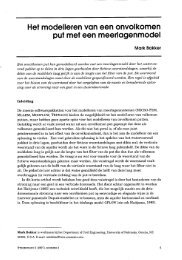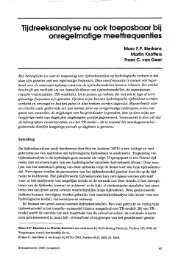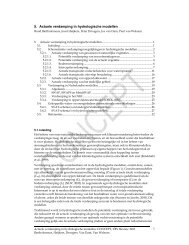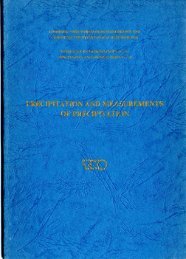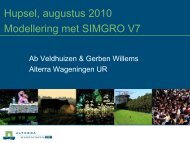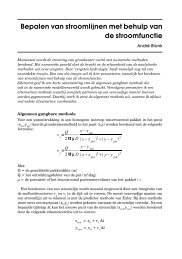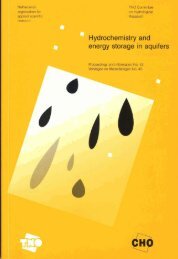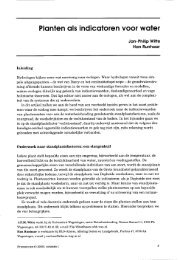Hydro-ecological relations in the Delta Waters
Hydro-ecological relations in the Delta Waters
Hydro-ecological relations in the Delta Waters
Create successful ePaper yourself
Turn your PDF publications into a flip-book with our unique Google optimized e-Paper software.
are taken. The first year after <strong>the</strong> desal<strong>in</strong>ikation proved mmre<br />
favourable thm predicted (<strong>the</strong> himas8 of algae was relatively small<br />
and transparency was ghod), but <strong>the</strong> <strong>in</strong>put of nutrients meds to he<br />
limited still fur<strong>the</strong>r <strong>in</strong> order to arrive at an endur<strong>in</strong>g Iavouzable<br />
water quality, In addition, "active biological management" should be<br />
considered, i,e. <strong>the</strong> applicatimn of biological management raeasnres to<br />
obta<strong>in</strong> a healthy water system wfth clear water, an abundance of aquatic<br />
plant@ and a stock of predatory fishes that wrll keep <strong>the</strong> whitefish<br />
with<strong>in</strong> bounds and hence allow sufficiefit eooplankton to rema<strong>in</strong> to graze<br />
on <strong>the</strong> algae.<br />
Eutrophication is <strong>the</strong> enriehmerrc of a water system r*ith plant nutrients<br />
(also simply called nutrients), of which nitrogen and phosphate are <strong>the</strong><br />
mast important. Eutrophication is partly a natural pzoeass: erosiofi and<br />
leach<strong>in</strong>g wash nutrients <strong>in</strong>ta zivers, wkich transport <strong>the</strong>m to <strong>the</strong> lower<br />
reaches. Therefore, delta areas are natur.%lly wtrophic, and <strong>the</strong> Dutch<br />
<strong>Delta</strong> area is a good example.<br />
In <strong>the</strong> last 100 years humanity has greatly exacerbated <strong>the</strong> natural<br />
process of eutrophication. The <strong>in</strong>srallatien of dra<strong>in</strong>s ad sewers, <strong>the</strong><br />
use of detergents and fertilizers and <strong>the</strong> <strong>in</strong>creas<strong>in</strong>g <strong>in</strong>tensfficstion of<br />
livestock fann<strong>in</strong>g have led t0 <strong>the</strong> amounta of nutrients <strong>in</strong> <strong>the</strong> rivers<br />
be<strong>in</strong>g <strong>in</strong>creased many times over.<br />
Tn sttagnant water <strong>the</strong> enrichraent with planr nutrients can lead to m<br />
<strong>in</strong>crease <strong>in</strong> <strong>the</strong> growth of algae, which can reault <strong>in</strong> high 4ensities of<br />
algae. Large numbezs of algae 14 <strong>the</strong> water results <strong>in</strong> a lev<br />
transparency; when <strong>the</strong> algae dh aeaerobim can occur and thie In turn<br />
can lead to fish mortality and a bad emell. Fur<strong>the</strong>rmore, toxic species<br />
of algae can occur (blue-green algae). Some species £am float<strong>in</strong>g mts.<br />
Sa~tions 2 aad 9 of this paper describe <strong>the</strong> eutrophication situation of<br />
two Serni-stagriant water systems <strong>in</strong> <strong>the</strong> <strong>Delta</strong> area: <strong>the</strong> nollands Dlepj<br />
Har<strong>in</strong>gvliet ad <strong>the</strong> Vohrak-Zwm lake system. The wtrophtcation state






